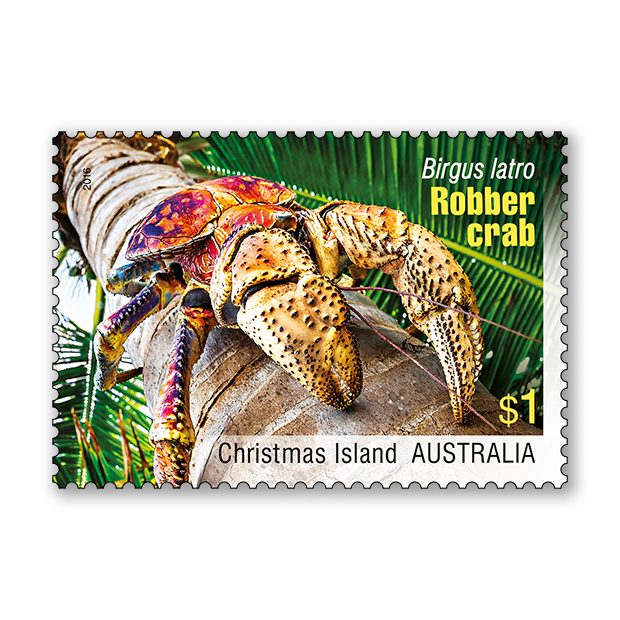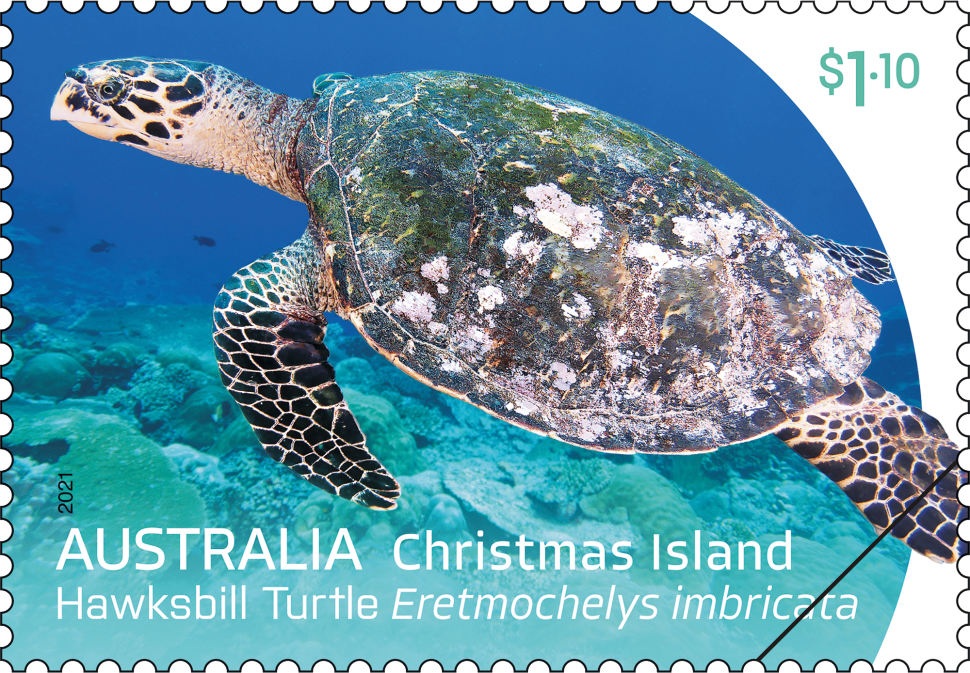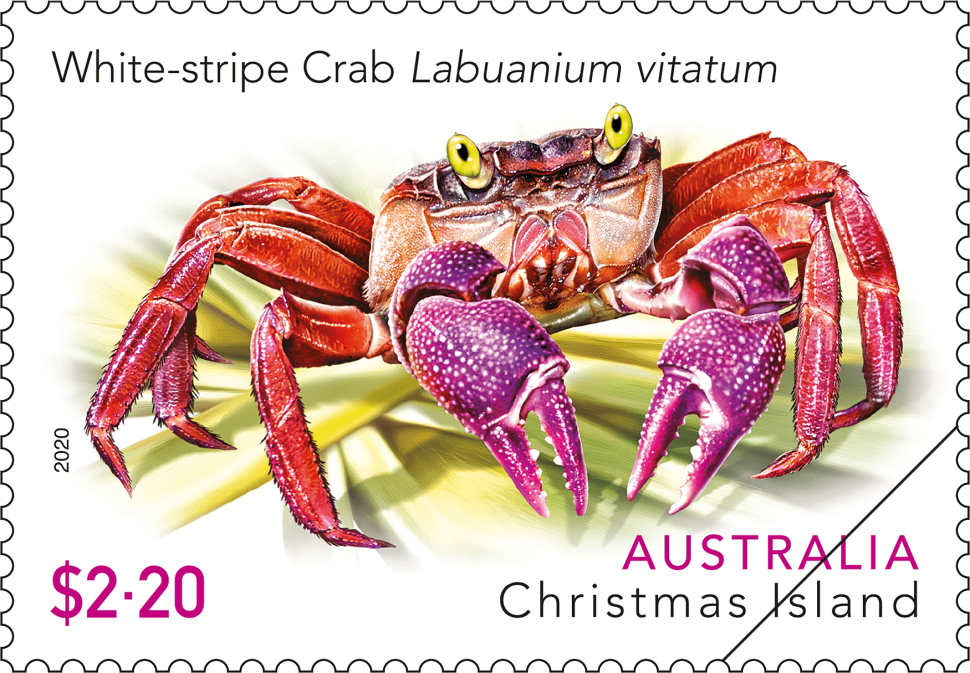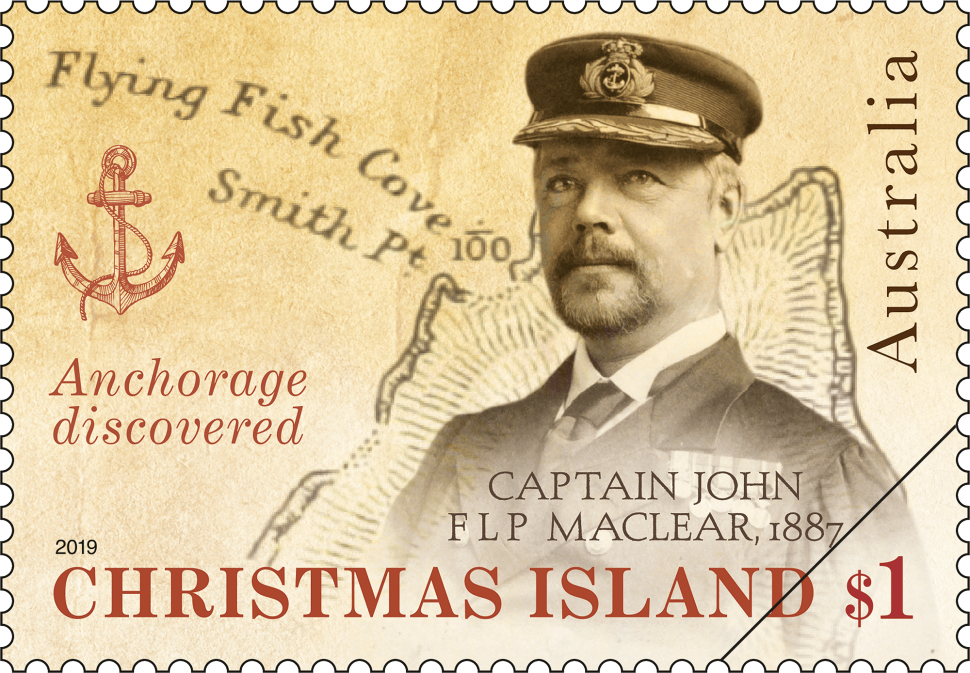While Christmas Island is famous for its endemic red crabs (the migration of which was the subject of a 2014 Christmas Island stamp issue), it is also home to the largest terrestrial arthropod on earth – the Robber Crab (Birgus latro), also known as the Coconut Crab. In fact, Christmas Island hosts the largest and best protected Robber Crab population in the world.
The Christmas Island Robber Crabs stamp issue, which will be released on 26 April, brings these enormous arthropods to life through some striking photography.
One thing that immediately strikes you about the Robber Crab is its sheer size; it is huge! In fact, a particularly large Robber Crab can weigh up to four kilograms and has an impressive leg span of around 800 millimetres. It is a strong species too; its large claws have extraordinary strength.
Robber Crabs from Christmas Island come in a range of body colours – from light violet to deep purple, purplish-blue or orange-red to brown.
Robber Crabs usually venture out at night or on overcast days, but on Christmas Island they are active both day and night. Unlike most crabs, the Robber Crab is almost entirely based on land, only returning to the sea to spawn. The female Robber Crab releases her eggs into the sea from the beach or from a cliff.
Max Orchard, a former ranger on Christmas Island and author of Crabs of Christmas Island, knows his crabs! Max was also a consultant on this stamp issue.
We asked Max to share his thoughts on this amazing species:
“Personally, I find Robber crabs to be one of the more amazing animals it has been my privilege to encounter during my forty years in natural area and wildlife management. They have evolved into a terrestrial air-breathing crustacean able to survive most capably out of the ocean. They are robust, rambling creatures that are really ‘smart’ at surviving the trials Mother Nature throws at them.
“This crab is found all over the island in uneven population densities. Robber crabs are highly mobile and omnivorous. They actively forage and feed on a wide variety of fruit as well as scavenge carcasses and hunt other crustacean species. Estimates by crab researchers in the 1980s put the Robber Crab population at around one to two million, however a recent study using different techniques suggests that the population on the island has declined substantially since the late 1980s.”
Despite this decline, Max notes that the International Union for Conservation of Nature and Natural Resources (IUCN) claims that there is not enough data to assess an extinction status. This means that the Robber Crab is currently classified as Data Deficient (DD), based on the IUCN Red List criteria.
“Christmas Island … represents one of the species’ major sanctuaries. The crab however is only accorded partial protection on the island. Robber Crabs are able to be taken by residents from areas outside the National Park and the golf course for private consumption. Hunting of Robber Crabs still occurs, but on a much reduced scale nowadays and is not considered a threat to the animal’s viability.
“Increased human population and activities, varied land use patterns that destroy habitat and introduced species invasions are, however, having an adverse effect. The Robber Crab has suffered extensive localised declines on the island due to the introduced Yellow Crazy Ant. Although Robber crabs are protected on most of the island, road kills have increased substantially in recent years due to an increasing human population and activities in areas of high crab population densities.”
The Christmas Island Robber Crabs stamp issue is available online from 26 April 2016, at participating Post Offices and via mail order on 1800 331 794, while stocks last.
Designer
Sharon Rodziewicz, Australia Post Design Studio
Technical specifications
- Issue date
- 26 April 2016
- Issue withdrawal date
- 31 October 2016
- Denominations
- 2 x $1 se-tenant pair, 1 x $2
- Stamp design
- Sharon Rodziewicz, Australia Post Design Studio
- Product design
- Sharon Rodziewicz, Australia Post Design Studio
- Printer - gummed
- RA Printing
- Paper - gummed
- Tullis Russell Red Phos
- Printing process
- Offset lithography
- Stamp size
- 37.5mm x 26mm
- Perforations
- 13.86 x 14.6
- Sheet layout
- Module of 50 no design
- FDI postmark
- Christmas Island WA 6798
- FDI withdrawal date
- 25 May 2016
This content was produced at the time of the stamp issue release date and will not be updated.








